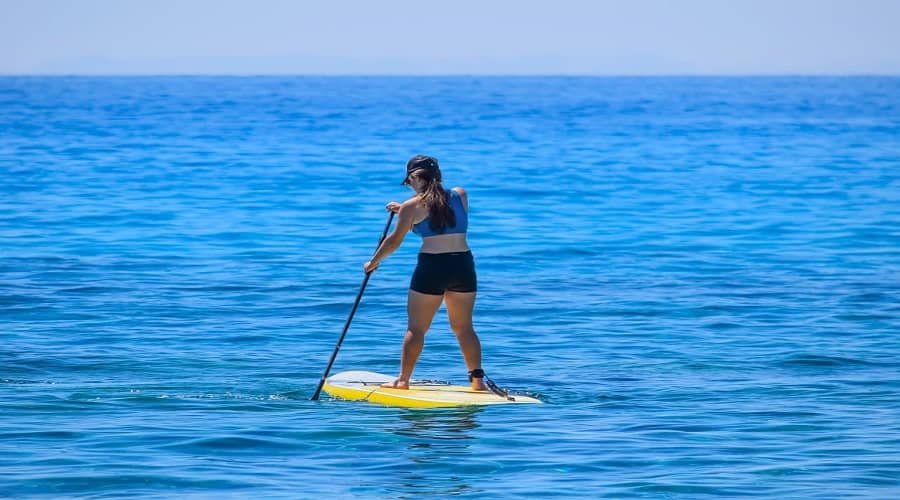How To Stand Up Paddle Board For Beginners
Stand up paddle boarding and skateboarding are fun sports that anyone can enjoy. However, beginners need to understand essential things to stand up paddle well. You can do paddle boarding in water bodies like oceans, lakes, or rivers. It looks like surfing, but the board is slightly bigger, and paddles are used.
Before engrossing in this fun activity, it is fundamental to know how to stand up paddle board. Check this guide on how to stand up paddle board for beginners and other pointers.
Contents
Know Your Stand Up Paddle Board and The Equipment You Need
You need the necessary equipment to stand up paddle board. Topping the list is the board itself. There are numerous types of stand up paddling boards.
As a beginner, look for a wider one. Besides, a broader board gives you confidence to take that first step and maximizes the stability.
Confirm your board has a leash. Leashes are used to secure you on the board. Attach the leash to your ankle or calf every time you paddle your board.
They come in different sizes and designs so you can always get one that suits you. Consider one that can easily be detached from your body if the board overpowers you in the water.
From the name of the recreation activity, paddling is involved. You need to get good quality paddles that are durable. Their height should be longer than that of a canoe paddle.
Pick a paddle that is several inches taller than you. It will save you the energy of bending down every time.
Since this activity is done in water bodies, it is mandatory to have a flotation device, especially for a beginner. Falling off the board is a common thing in this sport. You, therefore, need to take extra safety measures whenever you go paddling.
Know How to Stand Up On the Paddle Board
Standing up may seem easy, but it is a skill that you need to master when it comes to stand-up paddling. First things first, take the board to the water.
Walk with it till the fins no longer touch the floor surface of the water. Next, gently climb the board on a kneeling position and preferably at the center.
Staying in the middle of the board gives you more balance. Stroke the water from the sides to slowly push you forward.
Now carefully stand up, starting with one leg then the other. Maintain a shoulder-width distance between your legs. Keep your knees slightly bent to increase the stability.
Master The Paddling Techniques
Now that you have your gear and equipment and stand on the board, let's learn some paddling techniques. Correct paddling starts with holding the paddles correctly.
Hold the non-blade end of the paddle and not grip the paddle with your hands to close to each other. Maintain a shoulder-width between your hands grips.
To paddle forward, extend the paddle to the forward and bury it deep in the water. Pull the paddle through the water and past your paddle.
Do this a few times on one side then change to the other side. This will help you stay on a straight line. You can also use the paddle to turn right or left.
To turn left, you need to turn your torso to the left side and place the paddle in the water's right side. Pull through the water with the paddle, use your torso to lean to the left and get the direction.
To turn to the right, turn your torso to the right and place the paddle on the water's left side. Pull the water from the tail to the nose of the board.
Use Your Body Well
An advantage of stand up paddling is that you get a chance to strengthen your core while having fun. Additionally, for proper paddling and steering of the board, use your core. You need to use the core muscles more than your arms to paddle.
Using the arm muscles will make you tire faster and hence paddle for a short period. Moreover, the core muscles are powerful, efficient, and will help you keep your balance.
The other body part that plays a vital part in stand up paddle boarding is your head. As a beginner, you will always fear falling off the board, and so you will be tempted to look down.
Looking down disrupts your posture and balance. Always look up and maintain a straight posture. Also, keep your eyes open and do not want to get lost in the ocean.
Know The Wind Direction
The biggest blunder that most beginners make is ignoring the wind. In stand up paddling, your body acts as the mast.
This means that wind will have an impact on the direction you take. Strong winds may steer you in a completely different direction. You may even lose your balance.
Strong winds always come with some waves. It is crucial to anticipate the waves in that area before paddle boarding. Also, avoid strong waves.
If the winds and waves become stronger, bend over and reduce the surface area exposed. Use your board as a normal surfboard.
Do's
- Always use a leash whenever you are paddling. It is a safety measure that will keep you and your board near in case you fall off.
- Fall off the right way. If you feel you are falling off, then try and move away from the board. This will safeguard you from bumping your head and injuring yourself.
- Know the water before boarding. Is the water deep, is it calm, is it infested with any animals or insects? Is the water safe? Knowing this will avoid any unanticipated accidents and injuries.
Don'ts
- Do not paddle in waves that you cannot handle. If you are a beginner, be careful. Start with the baby steps. Get more skilful before attempting to do tough waves.
- Do not use your arm muscles only when paddling. Engage your back muscles to avoid tiring faster.
- Do not assume you are ready. Practice calm water several times before taking that big step.
Final Words
Take your time to understand all the dynamics of this activity. Do not just jump right in, learn the necessary techniques, find the correct gear and equipment, learn from experienced people, and prepare yourself. For the first time, go with a friend.
Other than the support they will offer; they can act as a lifeguard for you. How to stand up paddle board for beginners is now easy.
This is a fun outdoor activity and could double up as an exercising session. Your arm, back, and core muscles get the work out every time you paddle.

